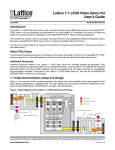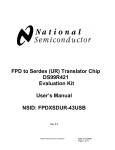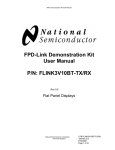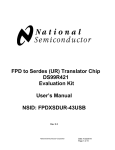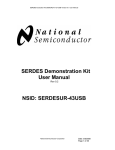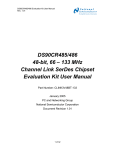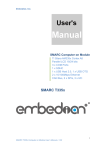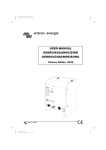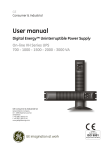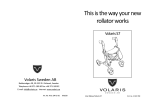Download DS92LV3241/DS92LV3242 Demonstration Kit User Manual
Transcript
DS92LV3241/3242 Evaluation Kit Users Manual Version 1.0 DS92LV3241/DS92LV3242 Demonstration Kit User Manual P/N LV32EVK01 Rev 1.0 National Semiconductor Corporation Date: 9/28/2009 Page 1 of 34 DS92LV3241/3242 Evaluation Kit Users Manual Version 1.0 Table of Contents TABLE OF CONTENTS ........................................................................................................................................... 2 INTRODUCTION: ..................................................................................................................................................... 3 CONTENTS OF THE EVALUATION KIT:........................................................................................................... 4 HOW TO SET UP THE EVALUATION KIT:........................................................................................................ 5 POWER CONNECTION: ......................................................................................................................................... 5 SERIALIZER (TX) BOARD DESCRIPTION: ....................................................................................................... 6 CONFIGURATION SETTINGS FOR THE SERIALIZER BOARD ......................................................................................... 7 SERIALIZER LVCMOS AND LVDS PINOUT BY IDC CONNECTOR ............................................................................ 9 DESERIALIZER (RX) BOARD: ............................................................................................................................ 10 CONFIGURATION SETTINGS FOR THE DESERIALIZER BOARD .................................................................................. 11 DESERIALIZER LVDS AND LVCMOS PINOUT BY CONNECTOR ............................................................................. 12 TYPICAL APPLICATIONS:.................................................................................................................................. 14 TROUBLESHOOTING ........................................................................................................................................... 16 APPENDIX................................................................................................................................................................ 17 BOM (BILL OF MATERIALS) SERIALIZER PCB: ...................................................................................................... 17 BOM (BILL OF MATERIALS) DESERIALIZER PCB:.................................................................................................. 18 SERIALIZER (TX) PCB SCHEMATIC:............................................................................................................... 19 DESERIALIZER (RX) PCB SCHEMATIC: ......................................................................................................... 23 SERIALIZER (TX) PCB LAYOUT: ...................................................................................................................... 27 SERIALIZER (TX) PCB STACKUP: .................................................................................................................... 30 DESERIALIZER (RX) PCB LAYOUT:................................................................................................................. 31 DESERIALIZER (RX) PCB STACKUP:............................................................................................................... 34 National Semiconductor Corporation Date: 9/28/2009 Page 2 of 34 DS92LV3241/3242 Evaluation Kit Users Manual Version 1.0 Introduction: National Semiconductor’s SERDES evaluation kit contains one (1) DS92LV3241 Serializer (Tx) board, one (1) DS92LV3242 Deserializer (Rx) board, and one (1) standard (~2) meter CAT 6 style cable assembly. Note: The demo boards are not intended for EMI testing. These demo boards were designed for easy accessibility to device pins with tap points for monitoring or applying signals, and additional pads for termination. The DS92LV3241/3242 chipset supports a variety of display and imaging applications. Typical applications include: navigation displays, automated teller machines (ATMs), POS, video cameras, global positioning systems (GPS), portable equipment/instruments, factory automation, printers, etc. The DS92LV3241 and DS92LV3242 can also be used as a 32-bit general purpose LVDS Serializer and Deserializer chipset designed to transmit data at clocks speeds ranging from 20 to 50 MHz in dual mode or 40MHz to 85 MHz in quad mode. The DS92LV3241 serializer board accepts LVCMOS input signals at either 3.3V or 1.8V. Note: IOVDD must be set to 3.3V for 3.3V input levels or 1.8V for 1.8V input levels. The LVDS Serializer converts the LVCMOS parallel lines into either two (2) serialized LVDS data pairs with an embedded LVDS clock on each channel or four (4) serialized LVDS data pairs with an embedded LVDS clock on each channel. The DS92LV3242 deserializer board accepts the LVDS serialized data streams with an embedded clock on each LVDS stream and converts the data back into parallel LVCMOS signals and clock. Note that NO reference clock is needed to prevent harmonic lock as with other devices currently on the market. Suggested equipment to evaluate the chipset include: an LVCMOS signal source, such as a video generator, word generator, or pulse generator and oscilloscope. The user needs to provide the proper LVCMOS clock and data inputs to the serializer and also provide a proper interface from the deserializer output to an LCD panel or test equipment. The serializer and deserializer boards can also be used to evaluate device parameters. National Semiconductor Corporation Date: 9/28/2009 Page 3 of 34 DS92LV3241/3242 Evaluation Kit Users Manual Version 1.0 Refer to the proper datasheet information on Chipsets (Tx/Rx) provided on each board for more detailed information. Contents of the Evaluation Kit: 1) One serializer board with the DS92LV3241 2) One deserializer board with the DS92LV3242 3) One 2-meter standard CAT 6 cable assembly 4) Evaluation Kit Documentation (this manual) 5) DS92LV3241/3242 Datasheet National Semiconductor Corporation Date: 9/28/2009 Page 4 of 34 DS92LV3241/3242 Evaluation Kit Users Manual Version 1.0 How to set up the Evaluation Kit: The PCB routing for the serializer input pins (TxIN) have been laid out to accept incoming LVCMOS signals from a 50-pin IDC connector. The serial interface between the DS92LV3241 and the DS92LV3242 uses a standard RJ-45 connector and CAT-5/6 cable assembly (small CAT-6 cable provided). The PCB routing for the Rx output pins (RxOUT) are accessed through a 50-pin IDC connector. Please follow these steps to set up the evaluation kit for bench testing and performance measurements: 1) A two (2) meter CAT 6 connector/cable assembly has been included in the kit. Connect one side of cable to the serializer board and the other side to the deserializer board. This completes the LVDS interface connection. 2) Jumpers and switches have been configured at the factory; they should not require any changes for immediate operation of the chipset. See text on Configuration Settings for more details. From the transmitting test equipment, connect a flat cable or fly wires (not supplied) to the Serializer board and connect another flat cable or fly wires (not supplied) from the Deserializer board to the receiving test equipment. Caution: The LVCMOS input levels should be within the specified range for optimal performance, not to exceed the absolute maximum rating of -0.3V to (VDD +0.3V). Note: For 50 ohm signal sources, add 50 ohm parallel termination resistors R1-R32 on the DS92LV3241 Serializer board and provide appropriate 3.3V LVCMOS input signal levels into TxIN[32:0] and TxCLKIN. Note: The Rx board may require the use of LVCMOS buffers to drive 50 ohm inputs found in some test equipment. 3) Power for the Tx and Rx boards must be supplied externally through Power Jack (VDD). Grounds for both boards are connected through Power Jack (VSS) (see section below). Power Connection: The serializer and deserializer boards must be powered by supplying power externally through J7 (VDD) and J8 (VSS) on the serializer Board and J6 (VDD) and J7 (VSS) on the deserializer board. Note +4V is the absolute MAXIMUM voltage (not operating voltage) that should ever be applied to the serializer (DS92LV3241) or deserializer (DS92LV3242) VDD terminal. Damage to the device(s) can result if the voltage maximum is exceeded. National Semiconductor Corporation Date: 9/28/2009 Page 5 of 34 DS92LV3241/3242 Evaluation Kit Users Manual Version 1.0 Serializer (Tx) Board Description: The 50-pin IDC connector J1 accepts 32 bits of LVCMOS RGB/generic data (TxIN0TxIN32) along with the clock input (TCLK). The SERDES serializer board is powered externally from the J7 (VDD) and J8 (VSS) connectors shown below. For the serializer to be operational, the Power Down (PWDNB) switch on S1 must be set HIGH. The board is factory configured (with series 0.1μF capacitors on the LVDS outputs. Rising or falling edge input clock is also selected on S1-TRFB: HIGH (rising) or LOW (falling). JP2 is configured from the factory to be tied to VDD (3.3V), which sets the LVCMOS I/O pins to operate at 3.3V logic levels. The RJ-45 connector P1 (on the bottom side of the board) provides the interface connection to the LVDS signals to the deserializer board. c LVDS OUTPUTS d LVCMOS INPUTS e FUNCTION CONTROLS f POWER SUPPLY g 50Ω INPUT f J7, J8 Note: VDD and VSS MUST be applied externally here. TERMINATION (For 50Ω signal sources, populated with 50ohm resistors to provide proper termination.) (IOVDD default setting IOVDD is connected to VDD) g J1 c g P1 (BOTTOM SIDE) (RJ-45) d g g e VR1, JP4 S1 e ASSY DS92LV3241 TX DEMO REV National Semiconductor Corporation Date: 9/28/2009 Page 6 of 34 DS92LV3241/3242 Evaluation Kit Users Manual Version 1.0 Configuration Settings for the Serializer Board S1: Serializer Input Features Selection Reference Description Input = L PWDNB PoWerDowN Bar Powers Down BISTEN BIST ENable TRFB Latch input data on Rising or Falling edge of TCLK Dual or Quad mode REServed MODE DB/Q RES_0 V SEL LVDS output VOD SELect BIST mode disabled (Default) Falling Edge (Default) Dual mode (Default) MUST be tied low for normal operation (Default) ≈440 mVP-P (Default) JP2: Serializer Input Features Selection Reference Description Default IOVDD 1.8V input Connected option. to VDD (J7) For 1.8V input swing IOVDD is connected to VDDI. VDDI must be applied on JP1 pin 1. Input = H Normal operation (Default) BIST mode enabled S1 Rising Edge Quad mode Not allowed ≈850 mVP-P External National Semiconductor Corporation JP2 Date: 9/28/2009 Page 7 of 34 DS92LV3241/3242 Evaluation Kit Users Manual Version 1.0 JP4,VR1: Pre-Emphasis Feature Selection Reference Description JP4 JP4 & VR1 Pre-Emphasis – helps to increase the eye pattern opening in the LVDS streams by providing current boost Pre-Emphasis adjustment (via screw) JP1 MUST have a jumper to use VR1 potentiometer. VR1 = 0Ω to 20 kΩ, JP1 + VR1 + 12 kΩ (R34) = ~12 kΩ (maximum preemphasis) to ~32 kΩ (minimum preemphasis*). IPRE = [1.2/(RPRE)] x 40, RPRE (minimum) > 12 kΩ OPEN (floating) Disabled – no jumper (Default) CLOSED (Path to GND) Enabled – With jumper Clockwise CounterClockwise increases RPRE value which decreases preemphasis decreases RPRE value which increases preemphasis *Note: maximum is based on resistor value. In this case ~32KΩ value is based on the ~12kΩ fixed resistor plus ~20KΩ maximum potentiometer value. User can use hundreds of k Ohms to reduce the preemphasis value. Pre-emphasis user note: Pre-emphasis must be adjusted correctly based on application frequency, cable quality, cable length, and connector quality. Maximum pre-emphasis should only be used under worse case conditions; for example at the upper frequency specification of the part and/or low grade cables at maximum cable lengths. Typically all that is needed is minimum pre-emphasis. Users should start with no pre-emphasis first and gradually apply pre-emphasis until there is clock lock and no data errors. The best way to monitor the pre-emphasis effect is to hook up a differential probe across the AC-coupling capacitors for the (+) and (-) inputs of the LVDS channels on the DS92LV3242 Rx demo board (NOT across the AC-coupling capacitors for the LVDS channels on the DS92LV3241 Tx demo board). National Semiconductor Corporation Date: 9/28/2009 Page 8 of 34 DS92LV3241/3242 Evaluation Kit Users Manual Version 1.0 Serializer LVCMOS and LVDS Pinout by IDC Connector The following two (2) tables illustrate how the serializer inputs are mapped to the IDC connector J1, the LVDS outputs on the RJ-45 connector P1 pinout. Note: Labels are also printed on the demo boards for both the LVCMOS input and LVDS outputs. TTL INPUT J1 Pin No. Symbol 2 TxIN0 4 TxIN1 6 TxIN2 8 TxIN3 10 TxIN4 12 TxIN5 14 TxIN6 16 TxIN7 18 TxIN8 20 TxIN9 22 TxIN10 24 TxIN11 26 TxIN12 28 TxIN13 30 TxIN14 32 TxIN15 34 TxIN16 36 TxIN17 38 TxIN18 40 TxIN19 42 TxIN20 44 TxIN21 46 TxIN22 48 TxIN23 50 TxIN24 52 TxIN25 54 TxIN26 56 TxIN27 58 TxIN28 60 TxIN29 62 TxIN30 64 TxIN31 66 TxCLKIN LVDS OUTPUT P1 Pin No. Symbol 1 OUT 0 + 2 OUT 0 3 OUT 1 + 4 OUT 2 + 5 OUT 2 6 OUT 1 7 OUT 3 + 8 OUT 3 - All Odd Pins GND National Semiconductor Corporation Date: 9/28/2009 Page 9 of 34 DS92LV3241/3242 Evaluation Kit Users Manual Version 1.0 Deserializer (Rx) Board: The RJ-45 connector P1 provides the interface connection for LVDS signals to the deserializer board. The deserializer board is powered externally from the J6 (VDD) and J7 (VSS) connectors shown below. For the deserializer to be operational, the Power Down (PWDNB) and Receiver Enable (REN) switches on S1 must be set HIGH. Rising or falling edge output clock is also selected by S1(R FB): HIGH (rising) or LOW (falling). The 50 pin IDC Connector J1 provides access to the 32 LVCMOS data and clock outputs. f J6, J7 Note: VDD and Gnd MUST be applied externally here e S1 g g d J1 c P1 (TOP SIDE) g d JP3 ASSY DS92LV3242 RX DEMO c LVDS INPUTS d LVCMOS OUTPUTS e FUNCTION CONTROLS f POWER SUPPLY g OPTIONAL PARALLEL LVCMOS LOADING PADS REV National Semiconductor Corporation Date: 9/28/2009 Page 10 of 34 DS92LV3241/3242 Evaluation Kit Users Manual Version 1.0 Configuration Settings for the Deserializer Board S1: Deserializer Input Features Selection Reference Description Input = L RSVD ReSerVeD MUST be tied low for normal operation (Default) RRFB Latch input data on Rising Falling Edge or Falling edge of (Default) RxCLKOUT PWDNB PoWerDowN Bar Power Down (Disabled) REN Receiver Output Data ENabled Disabled Input = H Not allowed S1 Rising Edge Normal Operational (Default) Enabled (Default) Output Monitor Pins for the Deserializer Board JP3: Output Lock Monitor Reference Description LOCK Receiver PLL LOCK Status Note: DO NOT PUT A SHORTING JUMPER IN JP3. Output = L Unlocked National Semiconductor Corporation Output = H PLL LOCKED (LED1 will illuminate) JP3 Date: 9/28/2009 Page 11 of 34 DS92LV3241/3242 Evaluation Kit Users Manual Version 1.0 Deserializer LVDS and LVCMOS Pinout by Connector The following two tables illustrate how the LVDS inputs are mapped to the RJ-45 connector J1 and the Rx outputs are mapped to the IDC connector J1. Note: Labels are also printed on the demo boards for both the LVDS inputs and LVCMOS outputs. LVCMOS OUTPUT J1 Pin No. Symbol 1 RxOUT0 3 RxOUT1 5 RxOUT2 7 RxOUT3 9 RxOUT4 11 RxOUT5 13 RxOUT6 15 RxOUT7 17 RxOUT8 19 RxOUT9 21 RxOUT10 23 RxOUT11 25 RxOUT12 27 RxOUT13 29 RxOUT14 31 RxOUT15 33 RxOUT16 35 RxOUT17 37 RxOUT18 39 RxOUT19 41 RxOUT20 43 RxOUT21 45 RxOUT22 47 RxOUT23 49 RxOUT24 51 RxOUT25 53 RxOUT26 55 RxOUT27 57 RxOUT28 59 RxOUT29 61 RxOUT30 63 RxOUT31 65 RxCLKOUT LVDS INPUT P1 Pin No. Symbol 1 IN 0 + 2 IN 0 3 IN 1 + 4 IN 2 + 5 IN 2 6 IN 1 7 IN 3 + 8 IN 3 - All Even Pins GND LVCMOS OUTPUT JP3 pin no. Symbol 1 LOCK (PLL) 2 GND National Semiconductor Corporation Date: 9/28/2009 Page 12 of 34 DS92LV3241/3242 Evaluation Kit Users Manual Version 1.0 Typical Connection and Test Equipment The following is a list of typical test equipment that may be used to generate signals for the TX inputs: 1) Digital Video Source – for generation of specific display timing such as Digital Video Processor or Graphics Controller with digital RGB (LVCMOS) output. 2) Astro Systems VG-835 - This video generator may be used for video signal sources for 6-bit Digital TTL/RGB. 3) Any other signal / video generator that generates the correct input levels as specified in the datasheet. 4) Logic Analyzer or Oscilloscope The following is a list of typically test equipment that may be used to monitor the output signals from the RX: 1) 2) 3) 4) LCD Display Panel which supports digital RGB (LVCMOS) inputs. National Semiconductor DS92LV3241 Serializer (Tx) Optional – Logic Analyzer or Oscilloscope Any SCOPE with a bandwidth of at least 170 MHz for TTL and/or 1 GHz for looking at the LVDS signals. LVDS signals may be easily measured with high impedance, low capacitance, high bandwidth differential probes such as the TEK P6330 differential probes. National Semiconductor Corporation Date: 9/28/2009 Page 13 of 34 DS92LV3241/3242 Evaluation Kit Users Manual Version 1.0 Typical Applications: Figure 1. Typical SERDES Application The chipset supports up to 30-bit color depth TFT LCD Panels. The picture below shows a typical test set up using a Graphics Controller and LCD Panel. Transmitter Board Receiver Board LCD Panel Digital RGB (TTL) from Graphic Contoller LVDS Interface Cable Digital RGB (TTL) to Panel Contents of Demo Kit Graphics Controller / Video Processor Board Figure 2. Typical SERDES Setup of LCD Panel Application National Semiconductor Corporation Date: 9/28/2009 Page 14 of 34 DS92LV3241/3242 Evaluation Kit Users Manual Version 1.0 The picture below shows a typical test set up using a generator and scope. Figure 3. Typical SERDES Test Setup for Evaluation National Semiconductor Corporation Date: 9/28/2009 Page 15 of 34 DS92LV3241/3242 Evaluation Kit Users Manual Version 1.0 Troubleshooting If the demo boards are not performing properly, use the following as a guide for quick solutions to potential problems. If the problem persists, please contact the local Sales Representative for assistance. QUICK CHECKS: 1. Check that Power and Ground are connected to both Tx AND Rx boards. 2. Check the supply voltage (typical 3.3V) and also current draw with both Tx and Rx boards. The Serializer board should draw about 150-200 mA with clock and all data bits switching at 85 MHz in Quad Mode, (RPRE=12 kΩ). The Deserializer board should draw about 240-265mA with clock and all data bits switching at 85 MHz in Quad Mode (8pF RxOUT loading). 3. Verify input clock and input data signals meet requirements for VILmin, VILmax, VIHmin, VIHmax, tSTC, tHTC), also verify that data is strobed on the selected rising/falling (RFB pin) edge of the clock. 4. Check that the Jumpers and Switches are set correctly. 5. Check that the cable is properly connected. TROUBLESHOOTING CHART Problem… There is only the output clock. There is no output data. Solution… Make sure the data is applied to the correct input pin. Make sure data is valid at the input. No output data and clock. Make sure Power is on. Input data and clock are active and connected correctly. Power, ground, input data and input clock are connected correctly, but no outputs. The devices are pulling more than 1A of current. After powering up the demo boards, the power supply reads less than 3V when it is set to 3.3V. Make sure that the cable is secured to both demo boards. Check the Power Down pins of both Serializer and Deserializer boards to make sure that the devices are enabled (/PWDB=VDD) for operation. Also check DEN on the Serializer board and REN on the Deserializer board is set HIGH. Check for shorts in the cables connecting the TX and RX boards. Use a larger power supply that will provide enough current for the demo boards, a 500mA minimum power supply is recommended. National Semiconductor Corporation Date: 9/28/2009 Page 16 of 34 DS92LV3241/3242 Evaluation Kit Users Manual Version 1.0 Appendix BOM (Bill of Materials) Serializer PCB: DS92LV3241 Tx Demo Board - Board Stackup Revised: Monday, September 21, 2009 DS92LV3241 Tx Demo Board Revision: 1 Bill Of Materials September 21, 2009 Item Qty Reference Part ______________________________________________ 1 2 3 4 2 2 2 8 5 8 6 8 7 8 8 9 10 11 12 13 14 15 16 17 2 1 2 1 4 1 2 1 1 32 18 19 20 21 1 1 2 10 22 24 25 26 27 6 1 1 1 1 C4,C1 C5,C2 C3,C6 C7,C8,C9,C10,C11,C12,C13, C14 C15,C16,C17,C26,C31,C34, C35,C38 C18,C21,C22,C25,C28,C29, C36,C37 C19,C20,C23,C24,C27,C30, C32,C33 JP1,JP4 JP2 JP3,JP5 J1 J2,J3,J4,J5 J6 J7,J8 J9 P1 R1,R2,R3,R4,R5,R6,R7,R8, R9,R10,R11,R12,R13,R14, R15,R16,R17,R18,R19,R20, R21,R22,R23,R24,R25,R26, R27,R28,R29,R30,R31,R32 R33 R34 R36,R35 R37,R38,R39,R40,R41,R42, R43,R44,R45, R52 R46,R47,R48,R49,R50,R51 S1 U1 U2 VR1 PCB Footprint 22uF 2.2uF 0.1uF 0.1uF CAP/N 3528-21_EIA CAP/HDC-1206 CAP/HDC-0603 22uF CAP/EIA-B 3528-21 0.1uF CAP/HDC-0603 0.01uF CAP/HDC-0603 2-Pin Header 3-Pin Header 2-Pin Header_open IDC2X33_Unshrouded IDC2X2_Unshrouded 2x4 pin Jumper_OPEN BANANA CONN JACK PWR_open RJ-45 8pin_open 49.9ohm_open Header/2P Header/3P Header/2P IDC-66 IDC-2x2 IDC_2x4 CON/BANANA-S 3-terminal thru hole power jack RJ-45_thru_hole RES/HDC-0201 49.9ohm_open 12.0K, 0402 332 ohm_open 0 Ohm,0402 RES/HDC-0805 RES/HDC-0402 RES/HDC-0805 RES/HDC-0402 10K SW DIP-6 DS92LV3241 LM3940/SOT223_open SVR20K RES/HDC-0805 DIP-12 64ld TQFP SOT223 Surface Mount 4mm Square National Semiconductor Corporation Date: 9/28/2009 Page 17 of 34 DS92LV3241/3242 Evaluation Kit Users Manual Version 1.0 BOM (Bill of Materials) Deserializer PCB: DS92LV3242 Rx Demo Board - Board Stackup Revised: Monday, September 21, 2009 DS92LV3242 Rx Demo Board Revision: 1 Bill Of Materials September 21, 2009 Item Qty Reference Part ______________________________________________ 1 2 3 4 5 6 7 8 9 10 11 12 13 14 15 16 17 18 19 20 21 22 23 8 C1,C2,C3,C4,C5,C6,C7,C8 33 C9,C10,C11,C12,C13,C14, C15,C16,C17,C18,C19,C20, C21,C22,C23,C24,C25,C26, C27,C28,C29,C30,C31,C32, C33,C34,C35,C36,C37,C38, C39,C40,C41 1 C42 1 C43 1 C44 9 C45,C46,C47,C54,C55,C66, C69,C70,C71 9 C48,C51,C53,C57,C59,C61, C62,C64,C67 9 C49,C50,C52,C56,C58,C60, C63,C65,C68 2 JP1,JP2 1 JP3 1 J1 4 J2,J3,J4,J5 2 J6,J7 1 J8 1 J9 1 LED1 1 P1 2 R2,R1 4 R3,R4,R5,R6 10 R7,R8,R9,R10,R11,R12,R13, R14,R15,R16 1 S1 1 U1 1 U2 PCB Footprint 0.1uF open0402 CAP/HDC-0603 CAP/HDC-0402 22uF 2.2uF 0.1uF 22uF CAP/N 3528-21_EIA CAP/HDC-1206 CAP/EIA-B 3528-21 0.01uF CAP/HDC-0603 0.1uF CAP/HDC-0603 2-Pin Header_open 2-Pin Header IDC2X33_Unshrouded IDC2X2_Unshrouded BANANA 2x4 pin Jumper_OPEN CONN JACK PWR_open 0603_green_LED RJ-45 8pin 332 ohm_open 10K 0 Ohm,0402 Header/2P Header/2P IDC-66 IDC-2x2 CON/BANANA-S IDC_2x4 3-terminal thru hole power jack 0603 (Super Thin) RJ-45_thru_hole RES/HDC-0805 RES/HDC-0805 RES/HDC-0402 SW DIP-4 DS92LV3242 LM3940/SOT223_open DIP-8 64ld TQFP SOT223 National Semiconductor Corporation Date: 9/28/2009 Page 18 of 34 DS92LV3241/3242 Evaluation Kit Users Manual Version 1.0 Serializer (Tx) PCB Schematic: National Semiconductor Corporation Date: 9/28/2009 Page 19 of 34 DS92LV3241/3242 Evaluation Kit Users Manual Version 1.0 National Semiconductor Corporation Date: 9/28/2009 Page 20 of 34 DS92LV3241/3242 Evaluation Kit Users Manual Version 1.0 National Semiconductor Corporation Date: 9/28/2009 Page 21 of 34 DS92LV3241/3242 Evaluation Kit Users Manual Version 1.0 National Semiconductor Corporation Date: 9/28/2009 Page 22 of 34 DS92LV3241/3242 Evaluation Kit Users Manual Version 1.0 Deserializer (Rx) PCB Schematic: National Semiconductor Corporation Date: 9/28/2009 Page 23 of 34 DS92LV3241/3242 Evaluation Kit Users Manual Version 1.0 National Semiconductor Corporation Date: 9/28/2009 Page 24 of 34 DS92LV3241/3242 Evaluation Kit Users Manual Version 1.0 National Semiconductor Corporation Date: 9/28/2009 Page 25 of 34 DS92LV3241/3242 Evaluation Kit Users Manual Version 1.0 National Semiconductor Corporation Date: 9/28/2009 Page 26 of 34 DS92LV3241/3242 Evaluation Kit Users Manual Version 1.0 Serializer (Tx) PCB Layout: ASSY DS92LV3241 TX DEMO REV PWB DS92LV3241 TX DEMO REV 1 TOP VIEW BOTTOMSIDE VIEW National Semiconductor Corporation Date: 9/28/2009 Page 27 of 34 DS92LV3241/3242 Evaluation Kit Users Manual Version 1.0 PRIMARY COMPONENT SIDE – LAYER 1 SECONDARY COMP SIDE – LAYER 4 PRIMARY COMP SIDE – SOLDER PASTE (LAYER 1) GROUND PLANE (VSS) – LAYER 2 PRIMARY COMP SIDE – SOLDER MASK (LAYER 1) POWER PLANE (VDD) – LAYER 3 SECONDARY COMP SIDE – SOLDER MASK (LAYER 4) SECONDARY COMP SIDE – SOLDER PASTE (LAYER 4) National Semiconductor Corporation Date: 9/28/2009 Page 28 of 34 DS92LV3241/3242 Evaluation Kit Users Manual Version 1.0 ASSY DS92LV3241 TX DEMO REV PRIMARY COMP SIDE – SILKSCREEN (LAYER 1) SILKSCREEN COMP SIDE – SILKSCREEN (LAYER 4) National Semiconductor Corporation Date: 9/28/2009 Page 29 of 34 DS92LV3241/3242 Evaluation Kit Users Manual Version 1.0 Serializer (Tx) PCB Stackup: National Semiconductor Corporation Date: 9/28/2009 Page 30 of 34 DS92LV3241/3242 Evaluation Kit Users Manual Version 1.0 Deserializer (Rx) PCB Layout: ASSY DS92LV3242 RX DEMO REV PWB DS92LV3242 RX DEMO REV 1 TOP VIEW BOTTOMSIDE VIEW National Semiconductor Corporation Date: 9/28/2009 Page 31 of 34 DS92LV3241/3242 Evaluation Kit Users Manual Version 1.0 PRIMARY COMPONENT SIDE – LAYER 1 SECONDARY COMP SIDE – LAYER 4 GROUND PLANE (VSS) – LAYER 2 POWER PLANE (VDD) – LAYER 3 PRIMARY COMP SIDE – SOLDER MASK (LAYER 1) SECONDARY COMP SIDE – SOLDER MASK (LAYER 4) PRIMARY COMP SIDE – SOLDER PASTE (LAYER 1) SECONDARY COMP SIDE – SOLDER PASTE (LAYER 4) National Semiconductor Corporation Date: 9/28/2009 Page 32 of 34 DS92LV3241/3242 Evaluation Kit Users Manual Version 1.0 ASSY DS92LV3242 RX DEMO REV PRIMARY COMP SIDE – SILKSCREEN (LAYER 1) SILKSCREEN COMP SIDE – SILKSCREEN (LAYER 4) National Semiconductor Corporation Date: 9/28/2009 Page 33 of 34 DS92LV3241/3242 Evaluation Kit Users Manual Version 1.0 Deserializer (Rx) PCB Stackup: National Semiconductor Corporation Date: 9/28/2009 Page 34 of 34 IMPORTANT NOTICE Texas Instruments Incorporated and its subsidiaries (TI) reserve the right to make corrections, modifications, enhancements, improvements, and other changes to its products and services at any time and to discontinue any product or service without notice. Customers should obtain the latest relevant information before placing orders and should verify that such information is current and complete. All products are sold subject to TI’s terms and conditions of sale supplied at the time of order acknowledgment. TI warrants performance of its hardware products to the specifications applicable at the time of sale in accordance with TI’s standard warranty. Testing and other quality control techniques are used to the extent TI deems necessary to support this warranty. Except where mandated by government requirements, testing of all parameters of each product is not necessarily performed. TI assumes no liability for applications assistance or customer product design. Customers are responsible for their products and applications using TI components. To minimize the risks associated with customer products and applications, customers should provide adequate design and operating safeguards. TI does not warrant or represent that any license, either express or implied, is granted under any TI patent right, copyright, mask work right, or other TI intellectual property right relating to any combination, machine, or process in which TI products or services are used. Information published by TI regarding third-party products or services does not constitute a license from TI to use such products or services or a warranty or endorsement thereof. Use of such information may require a license from a third party under the patents or other intellectual property of the third party, or a license from TI under the patents or other intellectual property of TI. Reproduction of TI information in TI data books or data sheets is permissible only if reproduction is without alteration and is accompanied by all associated warranties, conditions, limitations, and notices. Reproduction of this information with alteration is an unfair and deceptive business practice. TI is not responsible or liable for such altered documentation. Information of third parties may be subject to additional restrictions. Resale of TI products or services with statements different from or beyond the parameters stated by TI for that product or service voids all express and any implied warranties for the associated TI product or service and is an unfair and deceptive business practice. TI is not responsible or liable for any such statements. TI products are not authorized for use in safety-critical applications (such as life support) where a failure of the TI product would reasonably be expected to cause severe personal injury or death, unless officers of the parties have executed an agreement specifically governing such use. Buyers represent that they have all necessary expertise in the safety and regulatory ramifications of their applications, and acknowledge and agree that they are solely responsible for all legal, regulatory and safety-related requirements concerning their products and any use of TI products in such safety-critical applications, notwithstanding any applications-related information or support that may be provided by TI. Further, Buyers must fully indemnify TI and its representatives against any damages arising out of the use of TI products in such safety-critical applications. TI products are neither designed nor intended for use in military/aerospace applications or environments unless the TI products are specifically designated by TI as military-grade or "enhanced plastic." Only products designated by TI as military-grade meet military specifications. Buyers acknowledge and agree that any such use of TI products which TI has not designated as military-grade is solely at the Buyer's risk, and that they are solely responsible for compliance with all legal and regulatory requirements in connection with such use. TI products are neither designed nor intended for use in automotive applications or environments unless the specific TI products are designated by TI as compliant with ISO/TS 16949 requirements. Buyers acknowledge and agree that, if they use any non-designated products in automotive applications, TI will not be responsible for any failure to meet such requirements. Following are URLs where you can obtain information on other Texas Instruments products and application solutions: Products Applications Audio www.ti.com/audio Automotive and Transportation www.ti.com/automotive Amplifiers amplifier.ti.com Communications and Telecom www.ti.com/communications Data Converters dataconverter.ti.com Computers and Peripherals www.ti.com/computers DLP® Products www.dlp.com Consumer Electronics www.ti.com/consumer-apps DSP dsp.ti.com Energy and Lighting www.ti.com/energy Clocks and Timers www.ti.com/clocks Industrial www.ti.com/industrial Interface interface.ti.com Medical www.ti.com/medical Logic logic.ti.com Security www.ti.com/security Power Mgmt power.ti.com Space, Avionics and Defense www.ti.com/space-avionics-defense Microcontrollers microcontroller.ti.com Video and Imaging www.ti.com/video RFID www.ti-rfid.com OMAP Mobile Processors www.ti.com/omap Wireless Connectivity www.ti.com/wirelessconnectivity TI E2E Community Home Page e2e.ti.com Mailing Address: Texas Instruments, Post Office Box 655303, Dallas, Texas 75265 Copyright © 2012, Texas Instruments Incorporated




































